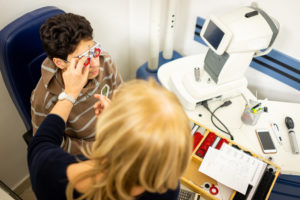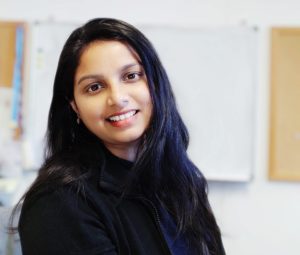October 1, 2021
By Divya Jagadeesh, PhD, Postdoctoral Research Fellow at the Brien Holden Vision Institute

This U.S.-based multiethnic study measured the accommodative responses of myopic children aged 6 to 14 years to investigate the role of accommodative lag on the rate of juvenile-onset myopia progression.
Measurement of Accommodative Responses
Monocular accommodative responses were obtained for all children that met the inclusion criteria, n= 592.
- Letter stimulus and autorefractor: A 4-D Badal accommodative stimulus that mimics the size of letters similar to children’s textbooks was used. The stimulus characteristics included a 4 x 4 grid of letters with each letter and the space between letters subtending 38.75 min of arc (20/155 equivalent) with the luminance of 30–50 cd/m2 was used.
- Accommodative lag before versus after: Two definitions were considered (1) Lag Before was defined as the accommodative lag at the beginning of each yearly interval, and (2) Lag After was defined as the accommodative lag at the end of each yearly interval.
- Near phoria was measured in prism diopters (PD) using an alternate cover test with prism neutralization with full correction. Near work was calculated based on the responses from an annual survey completed by each child’s parents using the formula: 3 × (hours studying + hours reading for pleasure) + 2 × (video/computer hours) + (hours watching television).
Findings
Both lag before and lag after were available for 500 children, and either the lag before (20) or lag after (72) measure was available for the remaining 92 children.
Lag before was not found to be associated with annual myopic progression. The lag before model (n=520) showed that older age was associated with decreased annual change in myopia or lesser progression (mean -0.42 ± 0.34D), and more esophoria was protective against myopia progression. It was also observed that girls had more myopic progression than boys.
Lag after was also not associated with annual myopic progression. The lag after model (n=572) showed that older age was not associated with a decrease in annual change in myopia or lesser progression (mean -0.46 ± 0.32 D). More exophoria was associated with slightly increased myopia progression with each prism diopter of exophoria, resulting in only -0.004D of myopic progression. In this model as well, girls had more myopic progression than boys.
Models combining lag before and lag after showed no interaction between near work and accommodation lag. Moreover, there was no effect of near work on myopia progression. The study also determined that the amount of myopia (high or low), in addition to higher accommodative lag, did not indicate that the child may have an increased annual myopia progression.
Since no association was observed between lag and myopia progression, it was concluded that the accommodative lag might result from myopia development rather than its cause. Other key findings from this study include: 1) decreased annual progression with older age (lag before model), 2) more esophoria that is protective against myopia progression (lag before model), and 3) girls had a higher myopic progression than boys (both lag before and lag after model).
Abstract
Accommodative Lag and Juvenile-Onset Myopia Progression in Children Wearing Refractive Correction
David A. Berntsen, Loraine T. Sinnott, Donald O. Mutti, Karla Zadnik, The CLEERE Study Group
Purpose: To investigate the role of accommodative lag on the rate of juvenile-onset myopia progression.
Methods: The relationship between accommodative lag and annual myopia progression was investigated using linear models in 592 myopic children wearing a full refractive correction in the Collaborative Longitudinal Evaluation of Ethnicity and Refractive Error (CLEERE) Study.
Results: The mean (± SD) age and spherical equivalent refractive error at baseline were 10.4 ± 1.8 years and -2.13 ± 1.24 D, respectively. The mean annual progression of myopia was -0.45 ± 0.32 D, and the mean accommodative lag (for a 4-D Badal stimulus) was 1.59 ± 0.63 D. Neither lag at the beginning nor at the end of a yearly progression interval was associated with annual myopia progression (all p ≥ 0.12).
Conclusion: These data suggest that foveal hyperopic retinal blur during near viewing may not drive juvenile-onset myopia progression.
Berntsen, D. A., Sinnott, L. T., Mutti, D. O., Zadnik, K., & CLEERE Study Group. (2011). Accommodative lag and juvenile-onset myopia progression in children wearing refractive correction. Vision research, 51(9), 1039-1046.
DOI: https://doi.org/10.1016/j.visres.2011.02.016

Divya Jagadeesh, PhD, is a postdoctoral research fellow at the Brien Holden Vision Institute.













